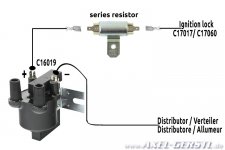fiat66
New member
- Joined
- Nov 13, 2016
- Messages
- 27
- Points
- 5
The idea of a ballast resistor is to reduce the coil voltage during normal running. Most older coils were designed to give maximal output at 12V, which they did all of the time. However, when starting the engine, the starter pulls such a large current, with a coincident voltage drop (to around 9V), that the nominal 12V coil would under perform and generate a weak spark making starting difficult, particularly in cold weather.
The solution was to fit a 9V primary coil which would give the same secondary output as a 12V coil and add a resistor in series to drop the voltage from the coil to 9V during normal running. When starting the engine, the resistor is bypassed and the coil receives the usual diminished voltage (~9V) which is now sufficient to give full output. Once the engine starts, the resistor is back in circuit so that the coil does not overheat.
Modern coils are much more efficient and have more stable output voltage with a variable input voltage so external ballast resistors are not needed.
The ignition setup in the picture is the 'wasted spark' ignition common on later model Polish air-cooled Fiats. The small domed 'distributor' contains points and advance mechanism and only switches the primary current. The coil has a twin output that fires the spark plugs simultaneously - one on the top of the compression stroke and the other (wasted) on the top of the exhaust stroke. No rotors and caps to wear out, but the condensers were still a major weak point.
Chris
PS: See here https://www.fiatforum.com/500-classic/359053-650cc-engine-electronic-ignition.html for a recent discussion.
Hi Chris !
Its been a while since your reply but hope you find time and interest to assist me.
I have recently bought a 500 with same ignition setup as Bleeding knuckles, so i guess i have a 126 polski engine.
Thing is my coil quit.
Got myself a new one, but added a ballast resistor, as this was recommended to me.
Compared to old coil it fells like engine runs a bit on the downside now.
I was told that with ballast i will not get 12 v but 9 v to sparkplugs , and that could explain why engine appears a little tired.
Should i at all have a ballast ?
Should i use ballast only during startup to save coil and add a switch in order to disconnect ballast after startup and get full effect on spark plugs ?
Coil is mounted right above exhaust on firewall and that is a bad place as it gets hot. Maybe i should move it to opposite side of fire wall ?
Thanks !
Per



